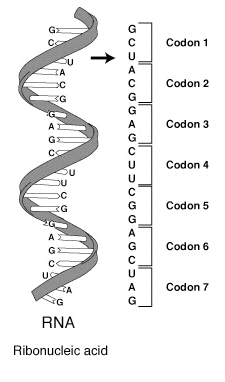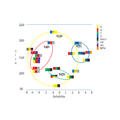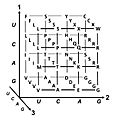Genetic code facts for kids

The genetic code is like a secret instruction manual for all living things. It's a set of rules that tells cells how to use the information in DNA or RNA to build proteins. Proteins are super important molecules that do most of the work in cells and make up much of the body's structure.
Think of it this way:
- DNA and RNA are like long messages written with just four letters: A, T, C, G (or A, U, C, G for RNA).
- The genetic code takes these letters and groups them into three-letter "words" called codons.
- Each codon usually stands for a specific amino acid. Amino acids are the basic building blocks of proteins.
Inside a cell, tiny machines called ribosomes read these mRNA messages. They use special "delivery trucks" called transfer RNA (tRNA) molecules. Each tRNA carries a specific amino acid and knows how to read a certain three-letter codon. As the ribosome moves along the mRNA, it reads each codon and adds the correct amino acid, one by one, to build a long chain. This chain then folds into a protein.
The amazing thing is that this genetic code is almost the same for all living things on Earth, from tiny bacteria to huge whales! This shows how connected all life is.
Contents
How the Code Works
The genetic code has 64 different three-letter codons. Since there are only 20 common amino acids, most amino acids are represented by more than one codon. This means the code has some "backup" options.
Reading the Genetic Message
When a cell needs to make a protein, it first makes a copy of a gene (a section of DNA) into a messenger RNA (mRNA) molecule. This process is called transcription. The mRNA then travels to a ribosome.
The ribosome reads the mRNA message one codon (three letters) at a time. For example, if the mRNA sequence is "AUG-GGC-UCA...", the ribosome would read "AUG" first, then "GGC", then "UCA", and so on.
Amino Acids: Protein Building Blocks
Each codon tells the ribosome which amino acid to add to the growing protein chain.
- For example, the codon "AUG" usually tells the ribosome to start making a protein and to add the amino acid methionine.
- Other codons, like "GGC", might tell it to add glycine.
- There are also special "stop" codons that tell the ribosome when the protein chain is complete.
Once all the amino acids are linked together in the right order, the chain folds up into a specific 3D shape, becoming a working protein. The shape of the protein decides what job it will do in the cell.
Why the Genetic Code is Important
The genetic code is fundamental to all life. It's how the instructions in our genome (all our DNA) are turned into the actual parts and tools that make our bodies work. Without this code, cells wouldn't know how to build proteins, and life as we know it couldn't exist.
The genetic code also helps scientists understand how evolution works and how different species are related. Because the code is so similar across all life, it suggests that all living things share a common ancestor.
Related pages
Images for kids
-
A series of codons in part of a messenger RNA (mRNA) molecule. Each codon consists of three nucleotides, usually corresponding to a single amino acid. The nucleotides are abbreviated with the letters A, U, G and C. This is mRNA, which uses U (uracil). DNA uses T (thymine) instead. This mRNA molecule will instruct a ribosome to synthesize a protein according to this code.
-
This 3D chart shows the first, second, and third positions in the codon. The 20 amino acids and stop codons (X) are shown using their single letter code.
See also
 In Spanish: Código genético para niños
In Spanish: Código genético para niños




